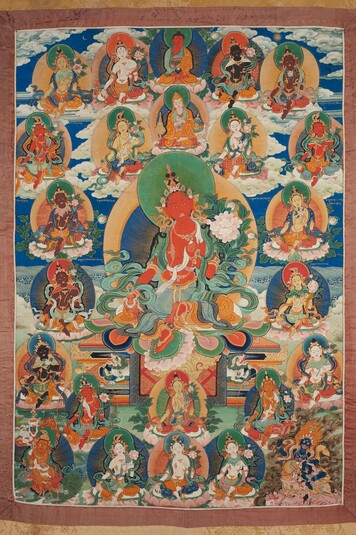
Item: Tara (Buddhist Deity) - (Atisha, 21 Taras)
| Origin Location | Tibet |
|---|---|
| Date Range | 1800 - 1899 |
| Lineages | Gelug and Buddhist |
| Material | Ground Mineral Pigment on Cotton |
| Collection | Private |
Red Tara (Tibetan: drol ma, English: Saviouress) together in the group known as the Twenty-one Taras according to the tradition of Jowo Atisha.
At the top center is Amitabha Buddha, red in colour, with Jowo Atisha directly below wearing the garb of a Buddhist monk. At the bottom left corner is the wealth deity Vaishravana Riding a Lion. At the bottom right is Shri Devi magzor Gyalmo riding a mule.
The Twenty-one Taras according to the tradition of Atisha is one of five Twenty-one Tara Sytems current in Tibetan Buddhism. The oldest system is likely that of Suryagupta. The Atisha system depicts all of the Taras with the same single face and two arms, in a sitting posture. The variations are in the Atisha system are in colour only. Each of the individual Taras holds a vase in the outstretched right hand. The vase is the same colour as the body colour of that Tara. Some of the Taras are described as being slightly fierce meaning they may have an open mouth with slightly enlarged canine teeth and furrowed brow above the eyes.
The Atisha system of Taras is probably the most commonly found in Tibetan painting. It is interesting to note that there is no Green Tara or a White Tara of Long-life (Chintachakra). These two forms of Tara originate with separate lineages of transmission and different Indian and Tibetan teachers. Also, the Tara known for removing the eight great fears is not associated with any of the five systems of Twenty-one Taras. Tara and the Eight Great Fears is a separate and distinct system. (See the list of colours & functions for the Atisha Twenty-one Taras).
This is quite possibly, of the paintings currently known, the very finest late style painting of the Twenty-one Tara subject.
Jeff Watt 9-2013
Buddhist Deity: Tara Iconography
Painting Style: Menri, Tashi Lhunpo Monastery
Buddhist Deity: Tara (Atisha Tradition)
Buddhist Deity: Tara, Red (Atisha Tradition)
Buddhist Deity: Tara, Twenty-one Taras (Atisha, Single Composition)
Buddhist Deity: Tara (Atisha Tradition, Masterworks)
Buddhist Deity: Tara, Red (Masterworks)
Buddhist Deity: Tara (Yoganiruttara, Anuttarayoga)
Buddhist Deity: Tara, Twenty-one Taras Main Page
Buddhist Deity: Tara Masterworks
Buddhist Deity: Tara, Red (All Forms)
Buddhist Deity: Tara (Compendium Paintings)
Buddhist Deity: Tara, Twenty-one Taras (Masterworks)






